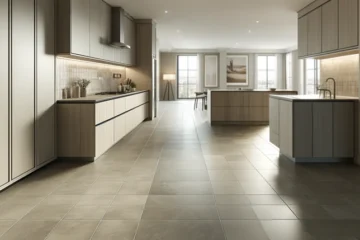How To Pick a Guest Room Color Scheme

Picking the right color scheme for a guest room can seem like a daunting task. After all, you want the room to feel inviting, but you also need it to appeal to a variety of tastes. Choosing the perfect color palette requires balancing style and comfort. A thoughtfully chosen color scheme can make guests feel at home, enhancing their experience while reflecting your personal style. In this guide, we’ll walk through the essential steps and considerations to help you choose a guest room color scheme that’s both welcoming and timeless.
By focusing on a few key elements, like color psychology, lighting, and even popular trends, we’ll make the decision-making process easier and enjoyable. Let’s jump into some of the top factors to keep in mind when picking the perfect color scheme for your guest room.
Why Does the Guest Room Color Scheme Matter?
Your guest room is more than just a spare space; it’s a place where visitors can relax, recharge, and feel like they’re home away from home. A well-chosen color scheme doesn’t just make the room look good—it impacts the mood and comfort level of your guests. Light colors, for instance, can make the space feel open and airy, while darker tones add coziness and warmth. The color scheme also ties into your home’s overall style, creating a cohesive flow that makes your whole home feel thoughtfully designed.
Understanding Color Psychology in Guest Room Design
Color psychology explores how different colors affect emotions and behaviors, which can be particularly useful when designing a guest room. By selecting colors that evoke a sense of calm and comfort, you can create an atmosphere that puts your guests at ease.
Choosing Calming Colors for Rest and Relaxation
Soft blues, greens, and neutrals are well-known for their calming effects, making them ideal choices for guest rooms. Blue shades, especially, are associated with tranquility and have been shown to help lower stress levels. Similarly, greens bring in a sense of nature and balance, helping guests feel grounded and relaxed.
Helpful Hint:
Want a universally appealing look? Stick to neutral tones like beige, gray, or light tan as your base. These shades provide a calm, inviting atmosphere and work well with various accent colors.
Adding Pops of Warm Colors for Energy
If you want to add a touch of energy without overwhelming the room, consider warm accent colors like soft yellows or corals. These colors add warmth and vitality, making the space feel cheerful without overpowering the main palette. Use these hues in smaller doses, like throw pillows, rugs, or wall art, to strike a balance between relaxation and liveliness.
Considering Lighting When Choosing a Color Scheme
Lighting can dramatically change the appearance of colors in any room, and guest rooms are no exception. Before finalizing your color scheme, consider how natural and artificial lighting will impact the way colors look in the room.
Color Combinations Based on Room Lighting
| Room Lighting | Recommended Colors | Effect on Room |
|---|---|---|
| Bright Natural Light | Cool shades (blues, greens, soft grays) | Feels open, refreshing, and calming |
| Limited Natural Light | Warm neutrals (beiges, soft yellows) | Enhances warmth and makes the space feel cozy |
| Artificial Warm Lighting | Earth tones (terracotta, olive green) | Creates an inviting, grounded ambiance |
| Artificial Cool Lighting | Pale tones (light gray, pale pink) | Feels fresh and balanced under cool lights |
Evaluating Natural Light Sources
If your guest room receives a lot of natural light, you may want to opt for cooler tones like light blues, greens, or grays. Natural light often brings out the true colors in these shades, helping the room feel fresh and airy. In rooms with limited natural light, warmer tones can add the feeling of warmth and make the space cozier.
Stats:
According to lighting experts, natural light is the most flattering light source, with 68% of homeowners reporting it makes rooms feel more welcoming.
Adjusting for Artificial Lighting in Guest Rooms
Artificial lighting also affects how colors appear. Cool LED lighting can enhance blues and greens, while warm incandescent or LED bulbs highlight warmer tones like yellow or beige. Think about your lighting plan as part of the design process to ensure colors stay true to your vision, both day and night.
Should You Consider a Neutral Color Scheme?
A neutral color scheme can be a foolproof option, especially if you want the guest room to appeal to a variety of tastes. Neutrals provide a blank canvas that can be easily accessorized with colorful pillows, blankets, and artwork. Additionally, a neutral palette allows guests to bring in their own belongings without clashing with the room’s decor.
Neutral Doesn’t Have to Mean Boring
Many people associate neutrals with plain or uninteresting spaces, but a well-chosen palette can be anything but dull. Consider using varying shades of beige, gray, and off-white to create depth and visual interest. Pairing light and dark neutrals can add dimension to the room, making it feel both spacious and cozy.
Adding Textures for Visual Interest
One way to enhance a neutral color scheme is through texture. Incorporate materials like wood, linen, or velvet to add richness to the room. Textures create a layered look that gives the space personality and warmth, helping neutrals feel engaging rather than stark.
Choosing Colors Based on Room Size and Layout
The size and layout of your guest room should also influence your color scheme choices. Colors can visually change the proportions of a room, making it feel larger or cozier depending on your needs.
Light Colors for Small Guest Rooms
If you’re working with a smaller guest room, light colors are your best friend. Shades of white, pale blue, or soft gray can make a room feel larger and airier. These colors reflect more light, creating the illusion of more space. For an added touch, consider a subtle accent wall to add interest without overwhelming the space.
Dark Colors for Larger Guest Rooms
In larger guest rooms, darker colors like deep greens, navy, or charcoal gray can add warmth and coziness. Darker shades make large spaces feel more intimate and welcoming. Pair dark walls with lighter bedding or furniture to balance the look and prevent the room from feeling too heavy.
Exploring Trending Colors for a Modern Look
If you’re interested in a more contemporary look, you might want to explore popular color trends. Trending colors can give the guest room a modern touch, though it’s best to choose shades that will still feel fresh and appealing over time.
Earthy Tones for a Natural Vibe
Earth tones, such as terracotta, olive green, and mustard yellow, are trending in interior design for their warm and inviting qualities. These colors bring a hint of nature indoors, which can create a grounding effect for guests. Use earthy shades on one or two walls or in accent pieces to give the room a cozy, nature-inspired aesthetic.
Helpful Hint:
Not sure how much color to add? Try using an “accent wall” approach, where one wall features a bolder shade, while the others remain neutral. This can make a statement without overpowering the room.
Finding the Perfect Accent Colors
Accent colors are a great way to add personality to your guest room without overwhelming the space. By selecting a few strategic accent colors, you can bring depth and interest to a neutral or muted primary color scheme. The key to success here is balance: choose accents that enhance the room’s main colors rather than compete with them.
Picking Complementary Colors for Balance
Complementary colors—those that sit opposite each other on the color wheel—naturally balance each other and can create a harmonious look. For example, if your main color is a cool blue, consider accents in warm tones like coral or peach. Similarly, if you choose a sage green for the walls, soft pink or gold accents can add warmth and contrast.
Using Analogous Colors for a Cohesive Look
Analogous colors, which are next to each other on the color wheel, provide a more subtle contrast. For a guest room with a calm vibe, consider pairing shades of blue and green or mixing various neutral tones like beige and gray. This approach creates a cohesive look with just enough variation to keep it interesting without being overwhelming.
Incorporating Patterns and Textures
Adding patterns and textures is a fantastic way to make the guest room feel dynamic and inviting. While solid colors lay the foundation, patterned items like pillows, rugs, and curtains can bring in visual interest without the need for additional colors. Textures, on the other hand, add a tactile element, making the space feel layered and cozy.
Choosing Patterns That Complement the Color Scheme
When selecting patterns, try to pick designs that complement the primary colors of the room. For example, if you’ve chosen a soft gray and beige palette, look for patterns that incorporate these tones, such as subtle stripes or florals. Aim to limit the number of patterns to two or three to prevent the room from feeling too busy.
Adding Texture with Fabrics and Materials
Textures can instantly elevate a room’s feel. Consider using materials like velvet, linen, or woven fabric in throw pillows, blankets, or rugs. You can also incorporate textured wall art, wooden accents, or metallic finishes to add character without altering the color scheme.
Seasonal Tips for Guest Room Colors
If you like to refresh your guest room decor seasonally, focus on colors and accents that can easily be swapped out. Seasonal updates let you adjust the ambiance to match the time of year, making guests feel especially welcomed and considered.
Winter: Embrace Cozy, Rich Hues
During winter, deeper colors like burgundy, forest green, or navy can create a cozy atmosphere. Use these colors in throw blankets, pillows, or even a seasonal rug. Layering these rich tones can make the room feel warm and inviting, perfect for colder months.
Spring and Summer: Lighten Up with Pastels and Fresh Greens
In spring and summer, consider freshening up the space with pastels, light neutrals, or green accents. These lighter shades can make the room feel airy and vibrant, echoing the season. For a quick update, switch out heavier textiles like wool blankets for lighter fabrics like cotton or linen.
How to Test Colors Before Committing
Sometimes a color looks great on a swatch but doesn’t work in the actual room. Testing your colors before committing can save time and ensure the finished look matches your expectations.
Using Sample Paints to See Colors in Different Light
Many paint companies offer small sample sizes, allowing you to try out colors on your walls. Paint a section of the wall and observe it throughout the day to see how it changes in different lighting. This will help you make a more informed choice, especially if the guest room has limited natural light.
Testing Fabrics and Decor Pieces
For items like bedding, curtains, or rugs, bring samples or swatches into the room to see how they look with the existing decor. Fabrics can sometimes appear darker or lighter depending on the room’s lighting and wall colors, so it’s wise to test these before buying larger pieces.
Helpful Hint:
If painting walls seems like too big of a commitment, consider peel-and-stick wallpaper as an alternative. It’s easy to apply, remove, and change whenever you want a new look.
Incorporating Artwork and Decor with Your Color Scheme
Artwork and decor are excellent ways to personalize a guest room. By coordinating these pieces with the room’s color scheme, you can add layers of personality without overcrowding the space.
Choosing Wall Art That Complements Your Colors
Look for artwork that incorporates some of the room’s main or accent colors. This creates a cohesive look and ties the room together. For example, if you have soft blues and grays in the room, artwork featuring similar tones can bring the color scheme to life.
Using Plants and Natural Elements as Decor
Adding plants is a fantastic way to bring freshness and natural color to the space. Plants like succulents, ferns, or even a vase of fresh flowers can brighten up the room and complement any color scheme. Plus, greenery pairs well with nearly any color, making it a versatile decor choice.
Creating a Timeless Look with a Balanced Color Scheme
A timeless color scheme can make the guest room feel fresh and welcoming, year after year. Classic, neutral palettes or soothing shades of blue and green tend to age well, adapting to changes in decor trends and personal tastes. By choosing colors that are both versatile and enduring, you ensure that the room feels updated without requiring frequent makeovers.
Opting for Classic Colors That Don’t Go Out of Style
Colors like navy blue, gray, beige, and soft white have a classic appeal that stands the test of time. These shades can be easily paired with new trends, keeping the room looking modern and fresh. Classic colors also adapt well to seasonal changes, making them a practical choice for guest rooms that may see different decor styles throughout the year.
Maintaining Flexibility with Accents
If you want to keep the room adaptable, stick to timeless shades for the main elements like walls and larger furniture. Use accent items like pillows, art, and decor to introduce current colors and trends. This way, you can easily switch out accents when you want a change, without repainting or buying new furniture.
FAQs
Wrapping Up
Choosing a guest room color scheme that combines comfort, style, and practicality can make all the difference in creating a warm and welcoming space. By understanding the impact of color, testing shades before committing, and balancing light with dark hues, you can craft a room that suits all types of guests. From using complementary accents to layering in textures, every choice adds to the inviting atmosphere. Remember, your guest room reflects your personal touch, creating a restful retreat that feels like a true home away from home.


